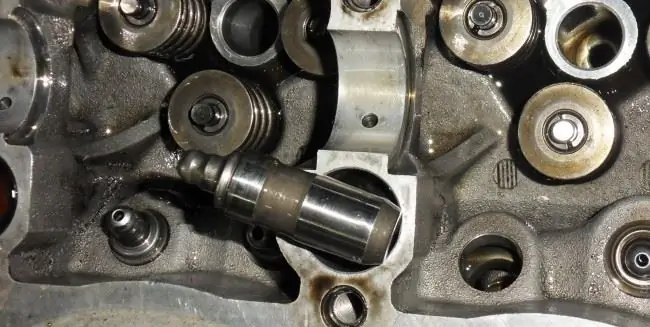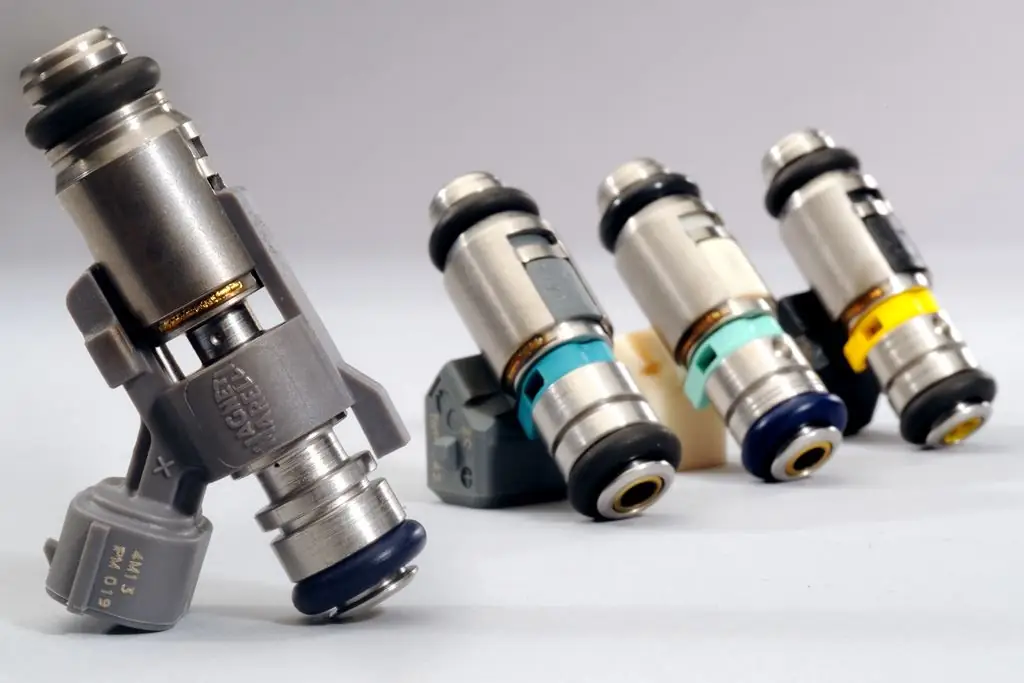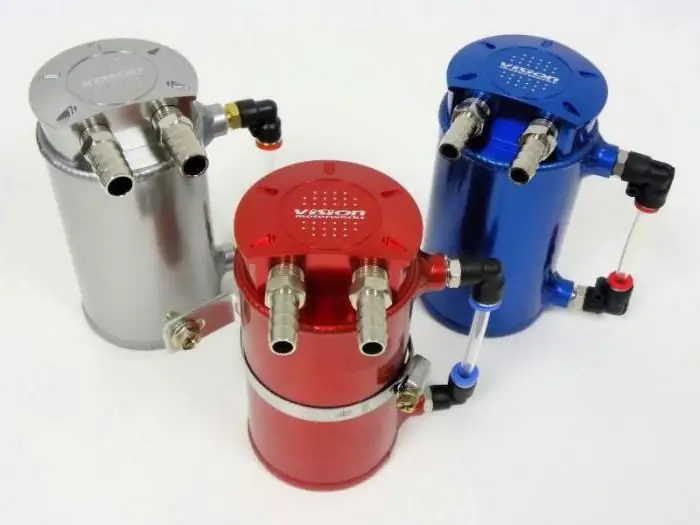2026 Author: Erin Ralphs | [email protected]. Last modified: 2025-01-22 21:14:14
PCV - forced crankcase ventilation system. The functioning of the power unit of the car largely depends on its condition.
What is the PCV system for?
The main task of this system is the removal of crankcase gases from the engine. They are available in all power units, regardless of their novelty and service life. The only difference between them is the composition and quantity. Crankcase gases are formed in the engine when the fuel-air mixture is compressed in the cylinders and during the working stroke, when the pistons go down and the mixture is already set on fire. Under high pressure, they enter the crankcase and often in small volumes into the valve covers.

In the crankcase, they interact with engine oil, starting to oxidize it. The pressure in the crankcase increases as gases continue to flow into it. Because of this, oil seals, a dipstick, or squeeze out the oil filler cap can be thrown out. Simply put, under increased pressure, the gases try to leave the crankcase and look for the weakest point for this. The PCV system exists to remove crankcase formations, it controls the pressure in the system. Gases are removed from valve covers by means of ventilation. Today, there are four main types of such systems.
Open system
A distinctive feature of this type of systems is the connection with the atmosphere. The gases accumulated in the crankcase are discharged under their own pressure through the ventilation valve. From an environmental point of view, this is not the best option, since they contain a large amount of harmful substances. In this case, the emission of gases is accompanied by an unpleasant odor and high temperature near the car.
Inlet open system
The design of this system is similar to the previous one. But at the same time it has a flow of air. Passing through the filter element, it enters the crankcase through a separate pipe, and from there it is discharged through the control valve into the atmosphere along with gases. This system is extremely rare. It has a large number of shortcomings, so it was practically not used in cars.

Closed flow system
The air entering the crankcase exits together with the gases through a special valve into the space up to the throttle valve. This system is rare. It has its pros and cons, as engine oil reacts with air.
Closed exhaust system
The most common system today. The gases accumulated in the crankcase are drawn out of it. The principle of operation of the system is as follows: behind the throttle valve not far fromThe intake manifold contains a branch pipe in which the PCV valve and the oil separator are located. When you press the accelerator pedal and open the damper, a vacuum is created in the intake manifold, which leads to air being drawn into it. Accordingly, back pressure is created in the valve nozzle. This leads to its opening and drawing crankcase gases into the intake, entering the combustion chamber and re-burning. From an environmental point of view, this system is the best.
PCV system design
Depending on the engine, the structure of the PCV system may be different. For V-shaped and in-line engines, it differs in the arrangement of parts: on the first engines, for example, there are two covers. Often, valve cover and crankcase ventilation systems are combined into one system. However, in general, the design of such systems is the same. The main elements are as follows:
- Tubes. Due to the vacuum formed in the intake manifold, gases are drawn through them. The strength of the nozzles must be high, since the substances removed are characterized by high temperature and no less pressure. In most cases, such parts are either plastic or reinforced. You can often find metal options.
- PCV valve. Regulates the process of removing crankcase gases and prevents air from entering. The PCV valve is blown only towards the manifold. When blowing towards the crankcase, it closes. However, both double-sided and electric valves can be found.
- Oil separator. There is always a specific fog in the crankcase space, since the detailsengines are constantly in motion. Accordingly, oil is distributed over them. Some systems have internal nozzles that spray it. The oil separator is designed to separate crankcase gases and oil, removing the former and leaving the latter in the engine.

Where is the PCV valve located?
Part location may vary depending on the specific make and model of vehicle and engine type. In most cases, it is located on the valve cover of the engine.
PCV design features
The main task of the PCV valve in the ventilation system is to regulate the pressure of crankcase gases by feeding them into the intake manifold. When braking the engine and idling, the throttle valve is slightly ajar. But at the same time, the volume of crankcase gases is low. Therefore, for normal ventilation, a small channel is sufficient. The valve spool in such a situation is retracted under the influence of a large vacuum. But the channel for supplying crankcase substances is blocked, releasing a small amount of them.
The number of formations in the crankcase increases sharply when you press the gas pedal and at high engine loads. Accordingly, the PCV valve will be positioned to release as much volume as possible. In such systems, there is usually a special flashback mode, which is characterized by the breakthrough of burning gases into the intake manifold from the cylinder. In this case, the crankcase ventilation PCV valve is under the influence of pressure, but not vacuum, which leads to its complete closure. This allowsprevent the possibility of ignition of fuel vapors accumulated in the crankcase.

Faults in the crankcase ventilation system
Failures in the PCV system can cause engine oil to leak. The pipes of the ventilation system, clogged, create excess pressure in the crankcase. This leads to the release of exhaust gases along with the oil from the engine. Initially, oil may come out through the dipstick hole at the joints and seals. The most unpleasant consequence may be squeezing out the seals. The failure of the oil separator of the ventilation system to work properly leads to the appearance of oil deposits on the air filter and throttle valve. If the PCV valve does not work correctly, this may cause a rich fuel mixture.
PCV valve whistle
Thin, barely audible engine whistle is a problem that owners of foreign cars of different brands often face. For example, he often worries the owners of the Nissan car. The PCV valve is the cause of this malfunction. The whistle appears due to the design features and operation of the part itself. The PCV valve is enclosed in a plastic housing, inside which there is a ball or piston, which is lifted from the side of the airflow inlet by a spring. In the non-working position, it is in the closed position.
When the volume of crankcase gases increases, air pressure is exerted on the valve. This leads to its displacement and the release of air flow into the system. Over time, the spring and housing walls become contaminated with small oil particles.particles, due to which the valve ceases to close tightly. When you press the accelerator pedal and open the throttle valve, a vacuum is created in the intake manifold, a large amount of air is drawn through the gap obtained, which causes the engine to whistle.

Eliminate whistle by cleaning the valve
The Lacetti PCV valve has a low cost, which saves on the repair of this car. However, in order to get rid of the whistle of the engine, it is not necessary to resort to replacing the part. The reason for the appearance of third-party sound is valve contamination. To eliminate such a malfunction, it is enough to clean the PCV valve of a Ford, Nissan or other car well. The design of the part is very simple. However, you should pay attention to the body, which on older models of cars was made of aluminum, and on new ones it is mainly made of plastic.
Cleaning the PCV valve
Clean the valve in a few steps:
- Withdrawal. To clean the valve, it must be removed. It is located next to the air filter housing. The valve may be located on the cover, attached to the crankcase ventilation pipes, or be elsewhere.
- Cleaning. Depending on the material from which the valve body is made, the method of cleaning varies, while applying mechanical force is not necessary. To clean an aluminum part, you can choose any cleaning agent: liquid or aerosol sprayed onto the surface or used as a cleaning bath. In the lastIn this case, the valve is placed in a container filled with detergent. Do not use aggressive compounds to clean plastic cases: they can damage the part, which can lead to its complete replacement.
- Installation. The cleaned part is returned to its place and fixed.
The PCV valve is easy to clean: you have Ford Focus, Nissan or Audi - it doesn't matter. Despite this, it is advisable to entrust the process to the masters. A good thorough cleaning will help eliminate the annoying whistle.

When should the valve be changed?
Many owners of imported cars are faced with the need to replace a consumable part such as a PCV valve. Chrysler quite often requires such a procedure. Symptoms that it is time to stock up on a new valve are the following:
- The appearance of a thin whistle under the hood of a car.
- Floating idle.
- Increasing the amount of oil in the intercooler. It is in it with a working PCV valve, but not in such large volumes.
- Increased oil consumption.
- Reducing boost pressure. In this case, the car behaves differently than before.
- Oil leaks from spark plug wells, oil filler or dipstick. As a result, this can lead to leakage of the crankshaft oil seals. Eliminating such a nuisance will result in a big penny.
- Puffs of dark gray smoke fly out of the exhaust pipe at idle.
PCV valve replacement
After purchasing the necessary parts, you can begin the process of replacing the valve. Whereinyou need to remember the following nuances:
- In order to replace or clean the PCV valve, the intake manifold must be removed. The procedure is simple and fast, it is enough to have the necessary tool at hand.
- The valve is located on top of the cylinder block, between their heads. Access to it is small, but it is quite enough for a replacement.
- The lower part of the collector can not be removed completely, just lift it up a little.
- There is a tube going to the PCV valve from under the "brains" of the car. It must be disconnected from the second part and both halves removed. As a result, only the valve itself will remain in the oil separator.
- It is desirable to clear the space around it. This is best done with airflow.
- The valve is unscrewed counterclockwise. It usually has a square ledge that facilitates the removal process. You can do this with platypuses - not very convenient, but fast.
- The unscrewed PCV valve must be inspected and tried to be blown out. This can be done with a clean thin hose. The part should be blown towards the collector.
- It is better to change a serviceable valve after 100 thousand kilometers.
- Install a new valve and assemble everything in reverse order.
At the same time, you can check the integrity and replace the nozzles if necessary. Their main faults:
- from time to time their upper part is flattened and starts to pump air;
- connections between hoses begin to siphon.
This is fixed quite simply - either by replacing the nozzles, or by smearing the seams andsealant connections. The valve replacement process is described in detail in the vehicle manual. In this case, the instruction is illustrated with the necessary photos.

The PCV valve is one of the parts of the crankcase ventilation system, on which the proper functioning of the car engine depends. Its malfunctions can lead to an increase in engine oil consumption, deterioration in controllability and failure of the power unit. Timely cleaning and replacement of the PCV valve will help prevent such consequences. Such procedures are carried out quickly and simply. They do not require large expenses and can be carried out independently, without the involvement of car service masters. The performance of a car engine depends only on its owner.
Recommended:
The principle of operation of the variator. Variator: device and principle of operation

The beginning of the creation of variable programs was laid in the last century. Even then, a Dutch engineer mounted it on a vehicle. After such mechanisms were used on industrial machines
Valve knock: principle of operation, characteristics, causes of knocking, diagnostics and troubleshooting

The gas distribution mechanism is an integral part of any internal combustion engine. The timing system includes several elements, including valves. These parts contribute to the intake of a combustible mixture and the subsequent release of gases from the combustion chamber. On a serviceable motor, the valves should not make any sounds. But what to do if there is a knock of valves? The reasons for this phenomenon and methods for troubleshooting - later in our article
Rough road sensor: what is it for, where is it located, the principle of operation

What is the rough road sensor for and how does it work? Everything you need to know about this device: purpose, principle of operation, possible malfunctions, features of diagnostics and replacement, as well as recommendations
Solenoid valve - device and principle of operation

The solenoid valve is an electromechanical device that is controlled by electric current. The latter passes through an electromagnet (a coil wound around the core), as a result of which a magnetic field is formed. By its action, it can open and - vice versa - close the solenoid valve
Carburetor and injector: difference, similarities, advantages and disadvantages of carburetor and injection engines, principle of operation and expert reviews

For more than a hundred years, the car has firmly established itself in our lives. During this time, managed to become a familiar, everyday means of transportation. Let's see what the difference is between a carburetor and an injector, what advantages and disadvantages they have

